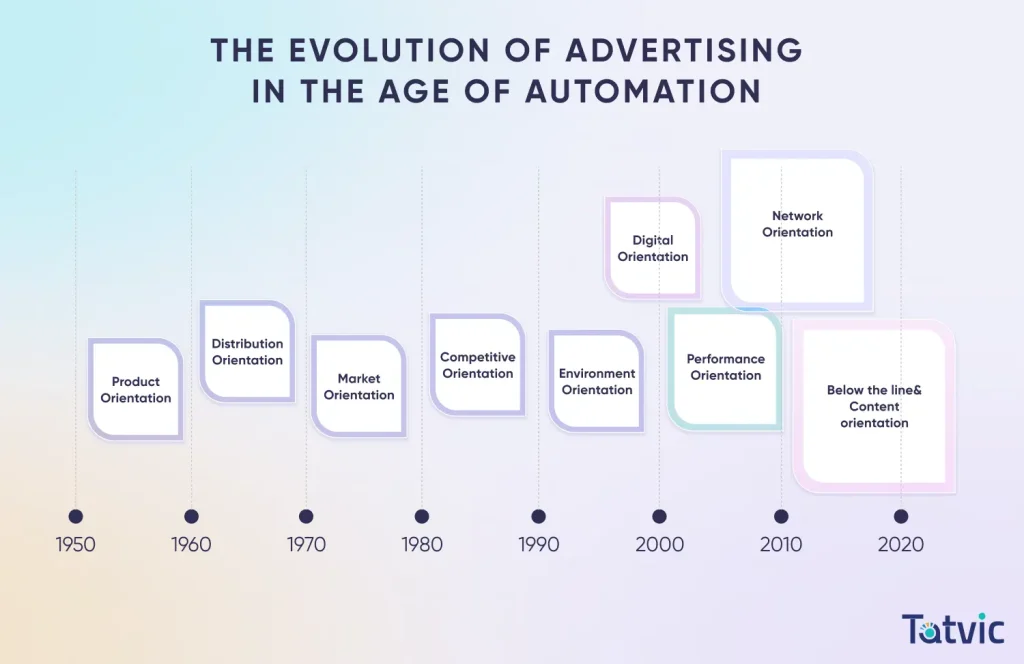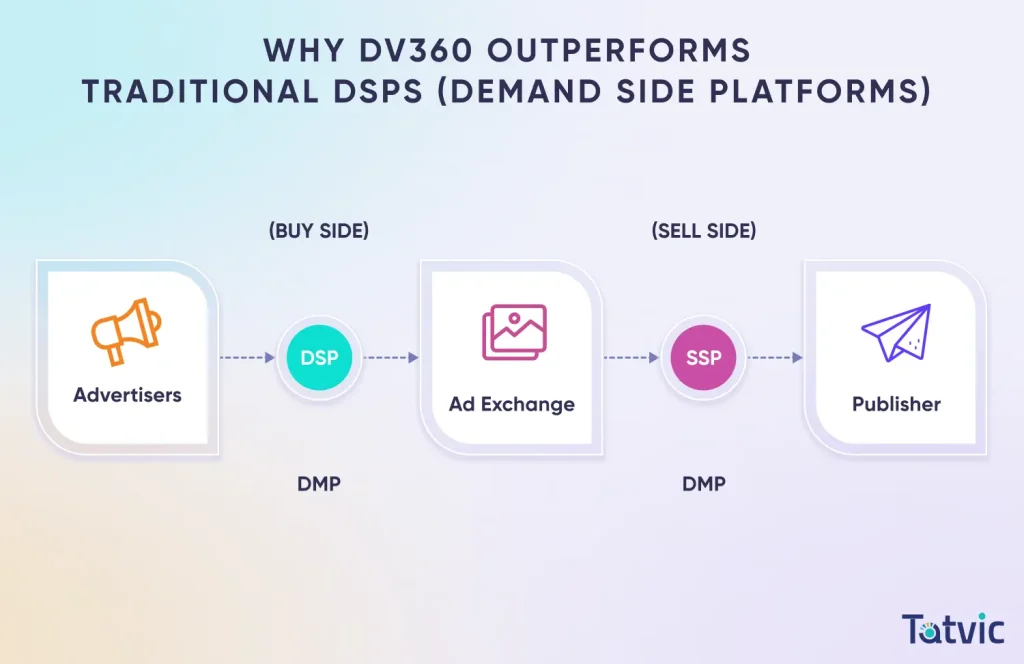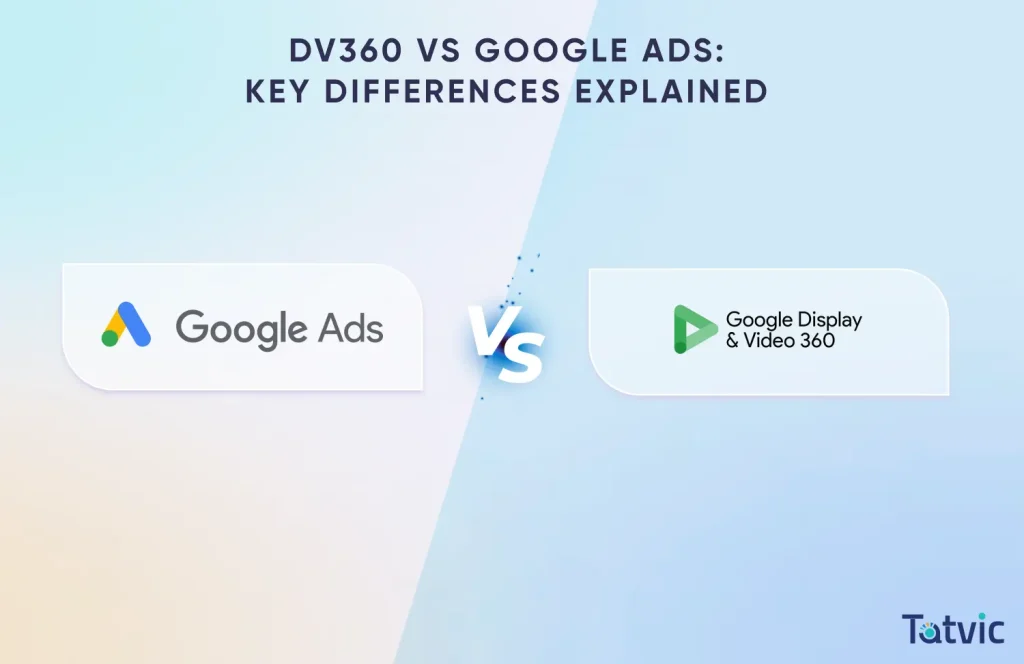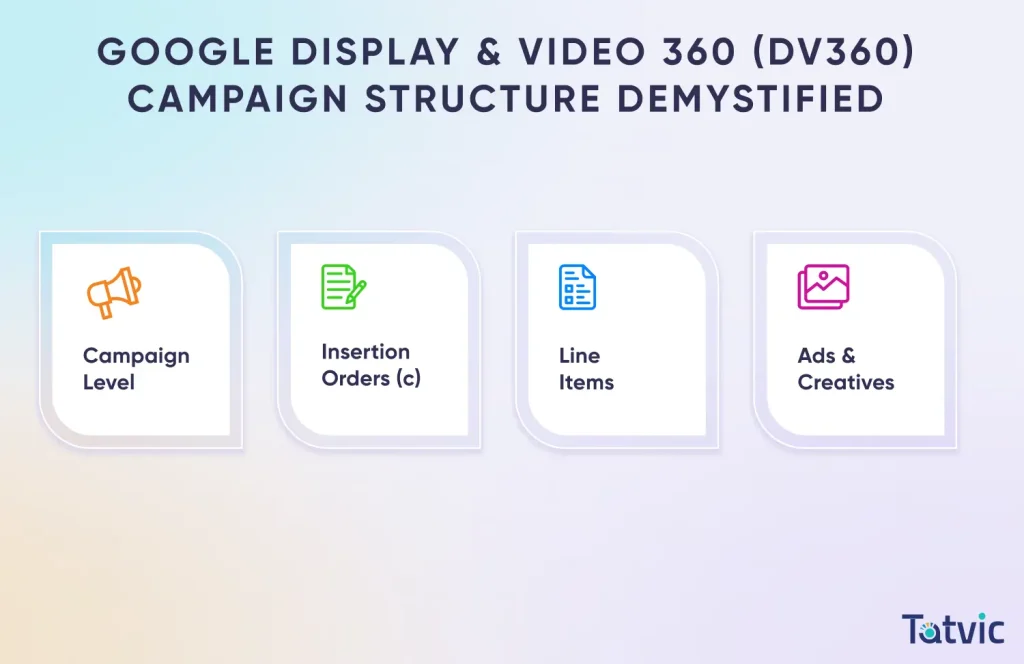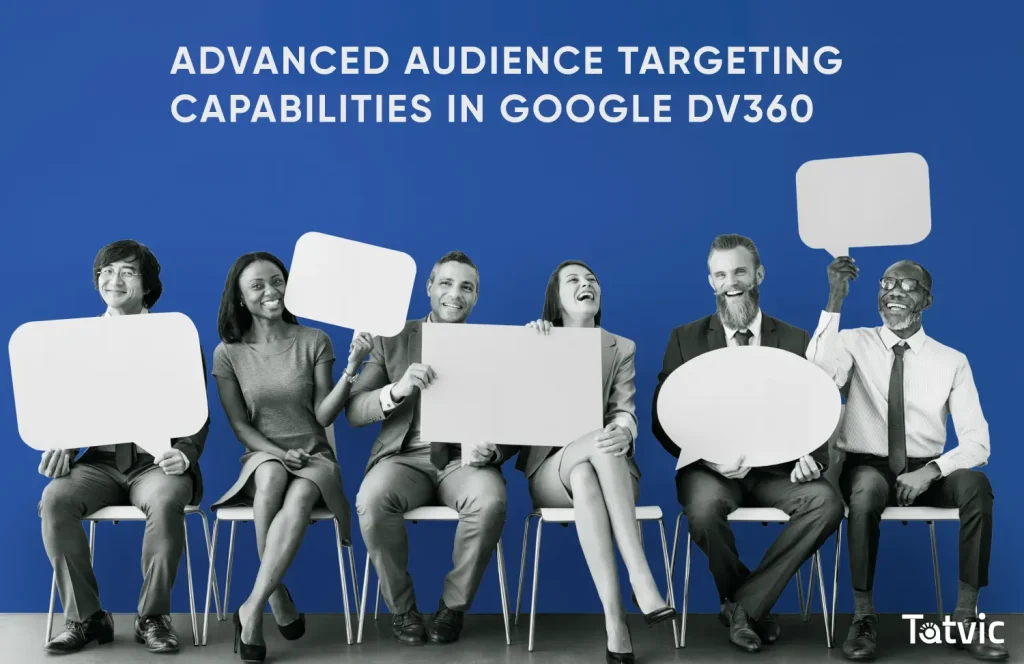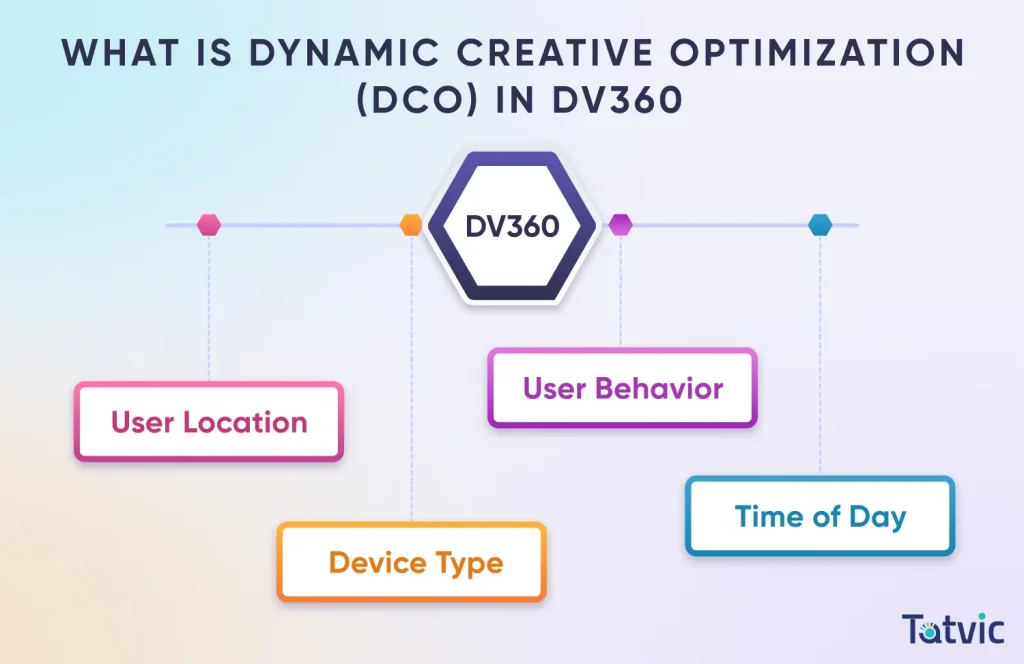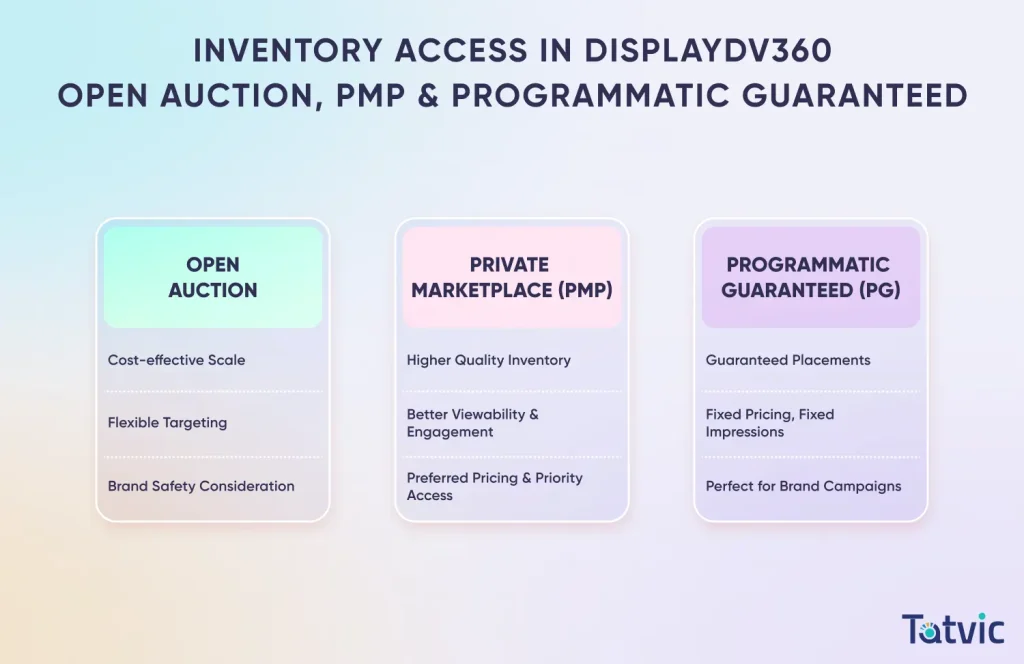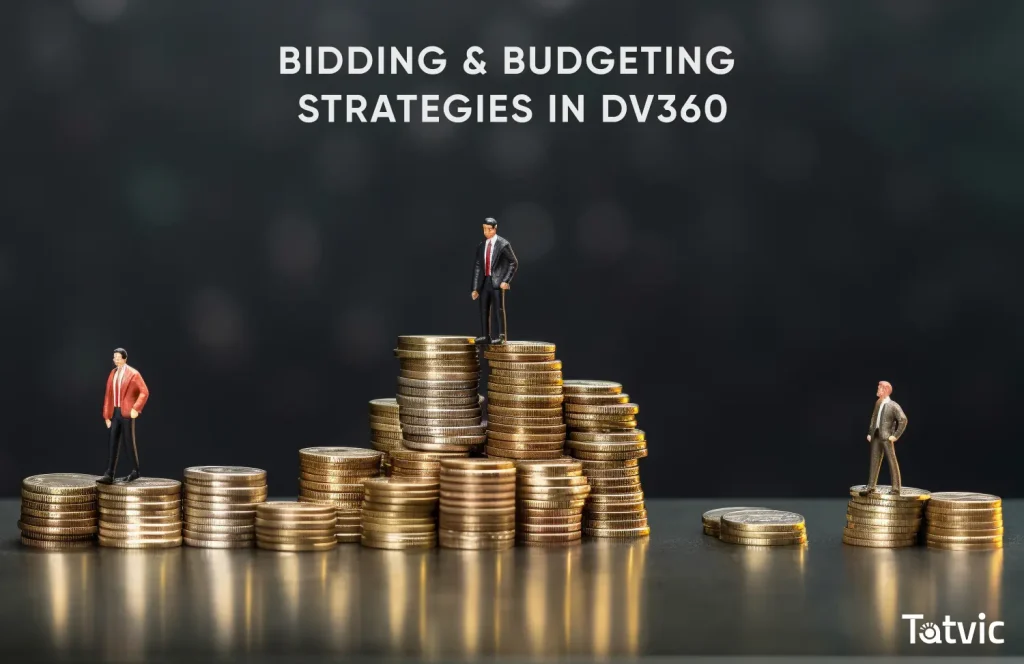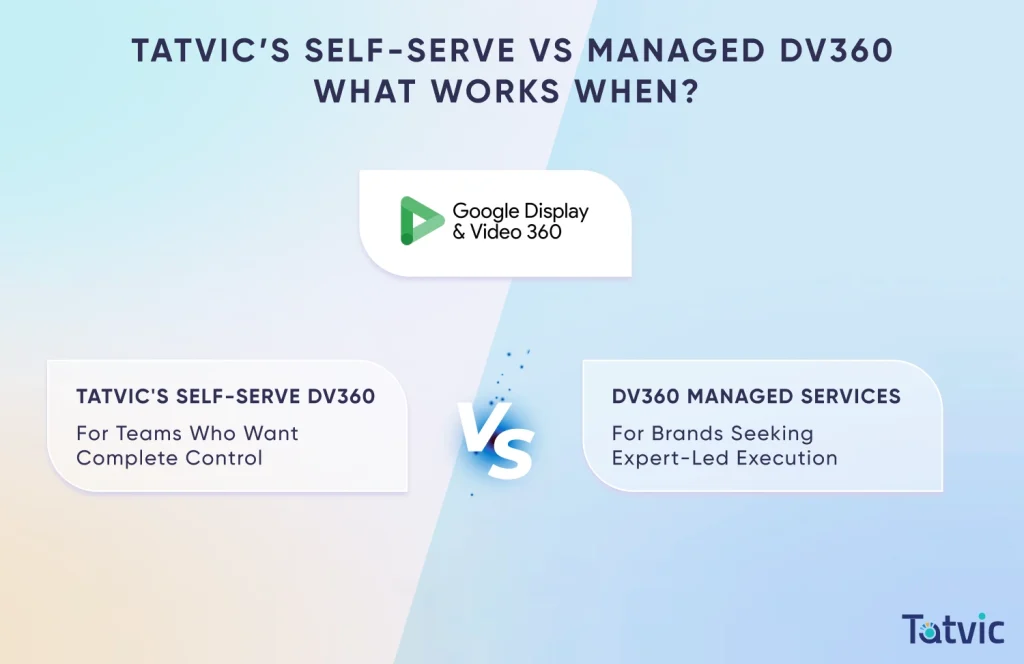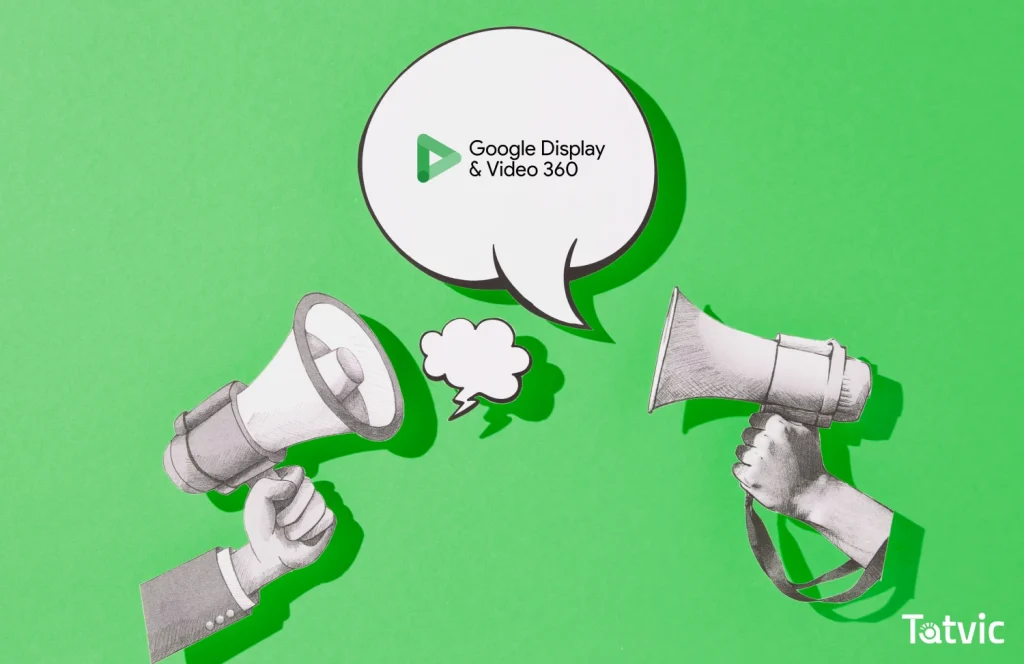Did You Know!
Google Display & Video 360 (DV360) offers extensive reach, covering 90% of the global internet and connects advertisers to more than 80 ad exchange networks across mobile, desktop, CTV, OTT, and linear TV platforms.
In this article discover how Google DV360 powers data-driven advertising with access to over 90% of global internet users through premium inventory, advanced targeting, and dynamic creatives.
This expert guide unpacks DV360’s capabilities which used by 80% of top global brands, to drive measurable outcomes across display, video, CTV, and audio campaigns.
The Evolution of Advertising in the Age of Automation
Digital advertising has evolved at a breakneck pace. With users spanning mobile, desktop, smart TVs, podcasts and OTT platforms, reaching the right person at the right time with the right message is no longer optional, it’s essential. This is where Google Display & Video 360 (DV360) shines.
As consumer journeys become increasingly fragmented, marketers need smarter tools to unify campaigns across channels. DV360 empowers brands to manage Display, Video, Audio and CTV Ads through one integrated platform.
With its advanced targeting, real-time optimization, and rich creative capabilities, DV360 helps advertisers maximize impact while minimizing waste. It’s not just automation, it’s intelligent and data-driven advertising at scale.
What is DV360 (Display & Video 360)?
Display & Video 360 (DV360) is Google’s enterprise-level demand-side platform (DSP) designed for programmatic media buying. It empowers advertisers to plan, buy, measure, and optimize digital campaigns all in one place. Unlike other DSPs that focus on media buying alone, DV360 is deeply integrated into the Google Marketing Platform (GMP), making it an end-to-end solution for advanced marketing teams.
DV360 stands out with its seamless access to premium inventory across Google and third-party exchanges, including YouTube, making it ideal for brand-safe, high-impact advertising. It combines data-driven audience targeting with real-time bidding and campaign insights. Whether you’re running display ads, video campaigns, or cross-device strategies, DV360 ensures precise control and unified reporting. This makes it a powerful tool for scaling performance in today’s programmatic ecosystem.
Core Capabilities of DV360:
Google’s Display & Video 360 (DV360) offers a comprehensive suite of programmatic tools designed to empower advertisers in the increasingly complex world of digital marketing. With its advanced features, DV360 enables brands to reach their audiences across multiple channels, optimize media spend, and harness data-driven insights to drive campaign success. Below are some of the key capabilities that make DV360 a go-to platform for performance-driven advertisers
Let’s deep dive into some of the Core Capabilities of DV360:
1. Cross-Channel Media Activation
DV360 enables advertisers to run campaigns across multiple digital channels—including display, video, audio, connected TV (CTV), and mobile—from a single, unified platform. This cross-channel flexibility allows marketers to create holistic strategies that deliver consistent messaging across the entire customer journey, improving both reach and frequency efficiency.
2. Advanced Audience Segmentation and Targeting
With DV360, advertisers can leverage Google’s robust audience data—along with first-party and third-party data—to build highly specific audience segments. Target users based on demographics, interests, browsing behavior, in-market signals, and even custom intent. This allows for hyper-personalized campaigns that drive engagement and conversions.
Example: A beauty brand can target makeup enthusiasts aged 18–34 actively browsing beauty tutorials on YouTube and related blogs.
3. Custom Bidding Strategies
One of DV360’s most powerful features is the ability to implement custom bidding algorithms. Advertisers can tailor bidding logic based on their unique business KPIs—whether it’s viewability, time on site, conversions, or ROAS. Custom bidding ensures every dollar is optimized toward what matters most to your brand.
Example: An eCommerce retailer might design a bidding model that prioritizes ad placements likely to convert high-value cart abandoners.
4. Seamless Integration with Google Stack (GA4, Campaign Manager 360, BigQuery, etc.)
DV360 integrates natively with Google’s ecosystem, including GA4 (Google Analytics 4), Campaign Manager 360, BigQuery, and Search Ads 360. This interconnected setup allows advertisers to easily import audiences, track cross-channel performance, attribute conversions, and analyze campaign results—all within a privacy-compliant environment.
Benefit: Faster, more accurate decision-making through consolidated reporting and unified KPIs.
5. Access to Premium Inventory (YouTube, OTT, PMP Deals)
With DV360, advertisers gain access to a vast range of premium inventory sources—from YouTube and top-tier publisher sites to Connected TV, OTT platforms, and Private Marketplace (PMP) deals. This ensures brand-safe placements, higher viewability, and greater control over where your ads appear.
Example: A travel brand can run skippable and non-skippable video ads on YouTube and OTT apps like Hotstar or Hulu, targeting vacation-intent users.
Expert View: Display & Video 360 is not just about reach—it’s about precision. With it, brands can build meaningful connections with customers at scale.
Why DV360 Outperforms Traditional DSPs (Demand Side Platforms)
Traditional DSPs may offer reach, but DV360 adds intelligence, control, and efficiency. Unlike traditional DSPs, which primarily focus on media buying, DV360 integrates with Google’s powerful ecosystem, enabling smarter audience targeting, real-time optimization, and richer data insights.
With access to premium inventory, including YouTube and CTV, along with customizable bidding strategies, DV360 allows brands to optimize their campaigns in a way that drives measurable results. It’s more than just a buying platform; it’s an intelligent tool designed to maximize ROI with advanced programmatic features.
Here’s what makes Google DV360 superior:
- Google Ecosystem Integration: Leverages first-party signals from Search, YouTube, Chrome and Gmail.
- Programmatic Guaranteed Deals: Direct inventory access with transparency and certainty.
- Data-driven Creatives: Serve hyper-personalized ads based on user behavior and context.
- Unified Reporting: Full-funnel insights from awareness to conversion.
Example: A global edtech brand used DV360 to deliver CTV ads to segmented student cohorts across SonyLiv and YouTube. Engagement rates improved by 42% compared to campaigns run on a legacy DSP.
DV360 vs Google Ads: Key Differences Explained
While Google Ads is designed for direct advertisers, DV360 is tailor-made for performance teams managing multi-channel campaigns with scale and complexity. While both DV360 and Google Ads are powerful tools for digital advertising, they serve distinct purposes.
- Google Ads is ideal for advertisers looking to run search campaigns or highly targeted display ads on Google’s owned properties, such as Search and YouTube. On the other hand,
- DV360 is designed for larger, programmatic campaigns across multiple channels, offering more advanced features like custom bidding strategies, audience segmentation, and access to premium inventory across Google and third-party exchanges. With DV360, advertisers gain greater control, efficiency, and cross-channel reach, making it the go-to solution for data-driven, large-scale marketing efforts.
Let’s See The Major Difference Between DV360 vs Google Ads
| Feature | Google Ads | Display & Video 360 |
| Inventory | Google Network only | Open Web + PMP + PG |
| Targeting | Standard audience tools | Advanced layering, GA4 integration |
| Creatives | Basic formats | Interactive, Video, CTV, Dynamic Creative Optimization (DCO) |
| Measurement | Campaign-specific | Full-funnel attribution with Campaign Manager 360 |
| Team Collaboration | Limited | Role-based, cross-team workflows |
Tip: Use Google Ads for quick tests and do scale winning experiments with DV360 for enterprise-grade execution.
Google Display & Video 360 (DV360) Campaign Structure Demystified
Building a successful DV360 campaign begins with a well-organized structure.
The hierarchy of campaigns, insertion orders (IOs), line items, and ads allows advertisers to manage, optimize, and scale their efforts efficiently.
Here’s a breakdown of the key components of DV360 Campaign Structure
1. Campaign Level
At the highest level of the DV360 campaign hierarchy, the Campaign Level defines the overall objective of the campaign. Whether you’re aiming for brand awareness, consideration, or conversion (action), this is where you set the foundation for your campaign’s strategy. Additionally, you’ll define important parameters like flight dates (start and end dates) and the budgeting framework to ensure optimal allocation of resources.
2. Insertion Orders (IOs)
Insertion Orders (IOs) are the next step in the hierarchy and allow you to allocate budget across different ad placements. This layer also involves setting frequency caps to control how often your ads are shown to users and defining key performance indicators (KPIs) such as CPM (Cost Per Mille), CPA (Cost Per Acquisition), or CPC (Cost Per Click). These metrics help ensure that your ad spend is aligned with your campaign goals and that the performance is continuously measured and optimized.
3. Line Items
Line Items are the heart of the campaign setup and represent the individual ad placements or targeting segments within your larger campaign. This is where you define the creative type (display, video, audio, etc.), specify the targeting layers (such as demographics, interests, and behaviors), and configure the bidding strategy (like CPM, vCPM, or tCPM). Each line item can be optimized for different goals and audiences, ensuring precision in delivering ads to the right users at the right time.
Example: A brand may create a line item targeting 18–34-year-olds in urban areas, bidding on vCPM for video ads to drive engagement.
4. Ads & Creatives
Finally, Ads & Creatives are linked to the assets you’ve uploaded within DV360. This includes the format-specific rules (e.g., VAST tags for video ads, HTML5 for display ads, or audio tags for streaming campaigns) that dictate how your creatives will function across different channels and devices. Ensuring that the ads are correctly linked and optimized for the chosen formats is critical for delivering seamless, engaging user experiences.
Pro Insight: Mirror your funnel stages in your IO structure:
Top Funnel = Awareness IOs
Mid Funnel = Engagement IOs
Bottom Funnel = Conversion IOs.
Advanced Audience Targeting Capabilities in Google Display & Video 360 (DV360)
One of the strongest advantages of Google Display & Video 360 (DV360) is its robust and intelligent audience targeting system. By layering multiple data sources and intent signals, DV360 enables advertisers to reach the right users at the right time with hyper-personalized messaging.
Here’s how the platform breaks down its advanced targeting options:
1. First-Party Audiences
DV360 allows seamless onboarding of first-party data, including customer lists, website visitors, and app users. You can import audiences directly from CRM systems, Google Analytics 4 (GA4), or Floodlight tags. This makes it easy to re-engage existing customers, nurture leads, or upsell to high-value users.
Example: A retail brand can retarget users who abandoned their carts in the past 7 days using email CRM data.
2. Google Signals: In-Market, Affinity and Demographics
Leveraging Google’s rich behavioral signals, DV360 offers a wide range of in-market, affinity, and demographic audiences. These are derived from billions of real-time intent signals such as search behavior, website visits, YouTube viewing patterns, and more.
- In-Market Audiences: Users actively researching or intending to buy (e.g., “home loans” or “luxury cars”)
- Affinity Audiences: Users grouped by long-term interests (e.g., “tech enthusiasts” or “fitness buffs”)
- Demographics: Targeting by age, gender, parental status, and household income
3. Third-Party Audience Segments
DV360 integrates with leading third-party data providers like Nielsen, BlueKai, Oracle, Lotame, and Acxiom. These segments provide rich behavioral, transactional, and intent-based data that can enhance your targeting precision, especially useful when you lack robust first-party data.
Example: A luxury automotive brand can use Oracle data to reach high-income users in-market for premium vehicles.
4. Custom Intent Audiences
With Custom Intent, DV360 allows advertisers to build audience segments based on users’ search keywords, visited URLs, and app usage patterns. This offers deeper control and lets you create highly tailored audiences that reflect real-time buying signals.
Example: A travel brand can target users who’ve searched for “cheap flights to Bali” or visited travel comparison sites in the past week.
5. Lookalike Modeling (Similar Audiences)
Lookalike modeling in DV360 allows you to scale your campaigns by finding new users who resemble your top-performing audiences. These similar audiences are modeled using machine learning and behavioral patterns, helping you extend reach without sacrificing quality or performance.
Example: An e-learning platform can create lookalikes of users who completed a course and achieved certification, then reach similar professionals across CTV and mobile apps.
By combining these layers, advertisers can build deeply targeted and efficient audience strategies within DV360—resulting in better engagement, higher ROI, and smarter use of media spend. Whether you’re working with first-party CRM lists or tapping into Google’s AI-powered signals, the platform offers flexibility and precision unmatched by most other DSPs.
Let me know if you’d like this adapted into a visual chart, training material, or landing page copy!
Example: A BFSI client layered users interested in “tax saving” with custom keywords and remarketing from their blog. The result? 1.9x higher lead qualification rate.
Creative Formats & Dynamic Messaging in Google Display & Video 360 (DV360)
In today’s digital-first landscape, capturing attention through creativity is just as critical as precision targeting. With Google Display & Video 360 (DV360), advertisers gain access to a versatile suite of creative formats that are designed to perform across screens, platforms, and user contexts. Whether you’re focused on storytelling, engagement, or conversion, DV360 enables you to tailor your messaging for maximum impact.
1. Display Banners
These are the classic static or animated ads that appear across websites and apps. Display banners are ideal for high-visibility branding campaigns, offering flexibility in sizes and placements across a vast inventory of publishers.
Example: A tech company promoting a product launch can run a series of branded display banners across news and gadget review sites.
2. HTML5 Interactive Ads
HTML5 creatives support advanced interactivity—such as carousels, hover effects, tap-to-reveal features, or drag-and-drop experiences. These ads drive deeper user engagement and are great for conveying layered information in a visually rich format.
Example: A real estate brand could use an interactive map that lets users explore properties based on location or budget.
3. Native Ads
Native ads appear seamlessly within the content layout of the hosting platform, creating a less disruptive, more contextual ad experience. These are effective in increasing trust and engagement, especially on editorial or content-heavy platforms.
Example: A SaaS company promoting a whitepaper can place native ads within a B2B news outlet to drive quality leads.
4. In-stream & Out-stream Video Ads
DV360 supports both in-stream video ads (e.g., pre-roll ads on YouTube or streaming platforms) and out-stream video ads (ads that autoplay in the middle of content or articles). These formats are perfect for storytelling and brand lift campaigns.
Example: A fashion retailer could showcase its seasonal collection with 15-second pre-roll ads before style-related YouTube content, while reinforcing messaging through out-stream ads on lifestyle blogs.
5. Audio Ads
Audio ads are ideal for reaching users in screenless environments such as while driving, cooking, or working out. DV360 provides access to major streaming platforms and podcasts, offering a new dimension for brand voice and recall.
Example: A meal delivery service could run 30-second audio spots on music apps during lunch hours to drive immediate app installs.
6. Connected TV (CTV) / OTT
With increasing cord-cutting trends, DV360 allows advertisers to deliver full-screen, non-skippable video ads on connected TVs and OTT platforms. These are excellent for high-impact campaigns with cinematic storytelling.
Example: An automotive brand can run a visually immersive ad on smart TVs during prime-time content to drive upper-funnel awareness.
What is Dynamic Creative Optimization (DCO) in Display & Video 360 (DV360)?
Dynamic Creative Optimization (DCO) is one of the most powerful personalization tools available in Google’s Display & Video 360 (DV360). It enables brands to deliver real-time, tailored ad creatives based on individual user data making your message more relevant, engaging, and likely to convert.
Rather than designing hundreds of static ads, DCO uses feed-based inputs to automatically update ad components like copy, visuals, and CTAs depending on who’s seeing it and when.
With DCO in DV360, your campaign isn’t just automated, it’s intelligent.
Here’s how Dynamic Creative Optimization (DCO) adapts to user context using real-time data:
1. User Location
DV360’s DCO engine can dynamically alter ad content based on the viewer’s geographic location—down to the city or even zip code level. This allows advertisers to run hyper-local promotions without building separate creatives for each region.
Example: A quick-service restaurant chain can showcase different combo deals for Mumbai vs. Delhi based on local preferences or weather (e.g., hot coffee in colder regions).
This geo-personalization not only increases relevance but also improves engagement rates and click-throughs across your Display & Video 360 campaigns.
2. Device Type
With users switching between mobile, desktop, and tablet throughout the day, a one-size-fits-all creative can lead to poor experience and wasted impressions. DCO in DV360 intelligently modifies ad layout, image resolution, or call-to-action (CTA) placement based on the device in use.
Example: A mobile ad might prioritize a tap-friendly CTA and simplified visuals, while a desktop version could display more in-depth information or include a carousel of products.
By optimizing for device context, Display & Video 360 ensures that your creatives are not just seen—but also experienced the way they were meant to be.
3. User Behavior
DV360 can tap into behavioral data to tailor ads according to user interests, past website visits, cart activity, or content consumption patterns. This means you can target returning users with different creative messages compared to new visitors.
Example: A user who previously browsed running shoes on an e-commerce site may see a personalized ad featuring discounts on the exact product they viewed or complementary items like socks or fitness trackers.
Leveraging behavioral cues in real-time helps Display & Video 360 advertisers drive conversions with precision-targeted messages that feel timely and relevant.
4. Time of Day
Not every message works at every hour. DCO in DV360 allows your ad creatives to shift depending on the time a user is served the ad—morning, afternoon, evening, or late night. This contextual delivery enhances relevance and attention.
Example: A coffee brand might show a breakfast combo before 10 AM, while the same placement at 6 PM may switch to a “Relax with our Iced Coffee” offer.
Such time-sensitive creative adjustments ensure that your Display & Video 360 campaigns are aligned with user behavior cycles, maximizing campaign effectiveness.
Why DCO in DV360 is a Game-Changer
Instead of creating dozens or hundreds of ad variations manually, DCO empowers marketers to create one smart creative that adapts automatically. This not only saves time and resources but also significantly enhances performance metrics like CTR, conversion rate, and return on ad spend (ROAS).
When paired with DV360’s robust reporting tools and machine learning-powered optimizations, DCO becomes a cornerstone for brands looking to deliver truly data-driven, audience-centric advertising at scale.
If you’d like help building a DCO strategy using Tatvic’s DV360 Self-Serve or Managed Services, we’re just a click away. Let us show you how personalization can scale without limits.
Inventory Access in Display & Video 360 (DV360): Open Auction, PMP & Programmatic Guaranteed
One of the biggest strengths of Google Display & Video 360 (DV360) lies in its access to a wide range of premium inventory channels. DV360 offers flexible buying options through Open Auction, Private Marketplace (PMP), and Programmatic Guaranteed (PG), each tailored to meet different campaign goals and brand requirements.
Understanding the nuances of each can help advertisers make smarter decisions and improve media efficiency across programmatic campaigns.
Let’s deep dive into Inventory Access in DV360:
1. Open Auction
The Open Auction is DV360’s default and most accessible buying method, where advertisers compete in real-time for ad impressions on a variety of websites and apps.
- Cost-effective Scale: This model is best suited for advertisers seeking broad reach at competitive CPMs.
- Flexible Targeting: You can layer in audience, contextual, or geo targeting without any upfront commitments.
- Brand Safety Consideration: Since the inventory is open to all buyers, there’s a higher chance of appearing on lower-tier publishers unless you apply strict brand safety filters or use pre-bid targeting.
Example: A consumer electronics brand looking to promote a flash sale might use Open Auction to flood display inventory across tech news and comparison sites at scale and speed.
While Open Auction is budget-friendly, Display & Video 360 provides advanced tools like inventory exclusions, brand safety settings, and verification tools to ensure campaign integrity.
2. Private Marketplace (PMP)
Private Marketplace (PMP) deals offer access to premium inventory, but unlike Open Auction, this is invitation-only and negotiated directly with publishers or networks.
- Higher Quality Inventory: You gain access to high-performing, brand-safe environments such as major news, lifestyle, or industry-specific publishers.
- Better Viewability & Engagement: Because you’re buying from vetted sources, PMP campaigns often yield higher viewability and better user interaction.
- Preferred Pricing & Priority Access: Though slightly more expensive than Open Auction, PMP deals often allow you to beat the competition in both inventory and placement quality.
Example: A fintech brand could use PMP deals to appear on leading financial news platforms like Bloomberg or Mint during budget season to capture a highly engaged audience.
For advertisers seeking both trust and transparency in their media buying, PMP via DV360 delivers the perfect middle ground between reach and premium quality.
3. Programmatic Guaranteed (PG)
Programmatic Guaranteed (PG) is the most premium inventory access model in DV360. With PG, advertisers lock in both ad inventory and pricing upfront offering predictability and priority delivery.
- Guaranteed Placements: Ideal for campaigns with strict flight dates or event-based strategies.
- Fixed Pricing, Fixed Impressions: No auction dynamics—your ad is guaranteed to run as per the contract.
- Perfect for Brand Campaigns: Especially valuable for awareness campaigns where premium visibility and user trust are critical.
Example: A healthcare client wanted guaranteed visibility during World Health Day. By leveraging Programmatic Guaranteed deals via Display & Video 360, they secured top placement on Healthline, YouTube Reserve, and other high-impact health-focused platforms—ensuring they reached their audience at the right moment with unmatched contextual relevance.
With Programmatic Guaranteed, you combine the best of traditional media buys (predictability) with the agility and targeting of programmatic—making it a powerful strategy for brand-heavy campaigns.
Choosing the Right Buying Method in DV360
Each inventory access type in Display & Video 360 serves a unique purpose:
- Open Auction = Maximum reach + agility
- PMP = Premium inventory + flexibility
- PG = Guaranteed exposure + brand safety
The choice often depends on your campaign goals, budgets, and risk tolerance. At Tatvic, we help clients strike the perfect balance between efficiency and effectiveness, whether you’re launching a mass-market campaign or aiming for hyper-targeted premium delivery.
Bidding & Budgeting Strategies in Display & Video 360 (DV360)
Setting the right bidding and budgeting strategy in Display & Video 360 (DV360) can mean the difference between hitting your KPIs or burning through your ad spend with little to show for it. DV360 provides powerful tools that cater to both novice and advanced media buyers allowing you to stay in control while leveraging Google’s machine learning to optimize performance at scale.
Display & Video 360 (DV360) Bidding Options
DV360 supports multiple bidding models designed to fit your specific campaign goals from awareness to conversion.
1. Manual Bidding (CPM, CPA, CPC)
Manual bidding gives advertisers complete control over what they’re willing to pay per impression (CPM), click (CPC), or acquisition (CPA). This is ideal when you have historical performance benchmarks and want to test specific thresholds.
Example: If you know your average CPA for newsletter sign-ups is ₹150, you can set that value manually to maintain budget efficiency.
2. Auto Bidding with Goal-Based Optimization
Let DV360’s algorithms work for you. Auto bidding evaluates real-time signals such as device, time, and user behavior to adjust your bid dynamically toward your chosen goal—whether that’s maximizing clicks, conversions, or viewable impressions.
This is especially useful for large-scale campaigns across multiple geographies and devices, where manual adjustments become cumbersome.
3. Custom Bidding Scripts
For advanced advertisers, DV360 allows custom bidding algorithms via scripts. You can define unique business goals and create bid logic accordingly.
Example: A streaming platform might optimize for users who watch at least 75% of a video (quartile views), not just impressions or clicks.
Smart Budgeting Tips for DV360 Optimization
Budgeting isn’t just about setting limits, it’s about driving efficiency and flexibility in your spend strategy.
Here’s how to be smart with budgets in Display & Video 360:
- Allocate 10–15% for Experimentation
Always reserve a portion of your budget to test new formats, creatives, or audience segments. This fosters innovation without risking core campaign performance. - Set Both Daily and Lifetime Budgets
This dual-layer approach ensures you don’t overspend, and gives you granular control over pacing and flight dates. - Choose the Right Pacing Strategy
-
- Even Pacing: Spend is distributed uniformly across the campaign duration.
- Ahead Pacing: Spends slightly faster to meet delivery goals early.
- ASAP Pacing: Prioritizes speed! Great for time-sensitive offers like flash sales.
-
Tip: If your product or service has a long consideration cycle (like real estate or enterprise SaaS), avoid relying solely on CPA bidding. Instead, start by optimizing for mid-funnel engagement metrics like video completions or site time.
Reporting, Measurement & Attribution in Display & Video 360 (DV360)
Success in DV360 isn’t just about launching campaigns, it’s about measuring what matters.
DV360 offers robust integrations and cross-platform visibility to ensure that every impression, click, and conversion is traceable and optimizable.
DV360 Reporting Ecosystem
1. Campaign Manager 360 (CM360)
CM360 powers your attribution model across touchpoints. It enables multi-channel tracking and deduplication of conversions, giving you a unified view of campaign impact.
2. Google Analytics 4 (GA4)
Integrate GA4 to understand user behavior post-click. Are users bouncing? Exploring product pages? Adding to cart? GA4 data enriches your DV360 campaign insights with on-site metrics.
3. BigQuery
For brands that need deep data slicing, DV360 integrates seamlessly with BigQuery. This allows custom queries, segmentation analysis, and predictive modeling on large datasets.
4. Looker Studio (formerly Data Studio)
Build real-time dashboards to monitor DV360 KPIs visually. You can segment performance by geo, device, audience, and creative type to make smarter optimization decisions.
Key Metrics to Track in DV360 Campaigns
- Viewability Rate : Percentage of impressions where the ad was visible on screen (as per MRC standards).
- Completion Rate: For video ads, how many users watched the entire video.
- CPM, CPC, CPA: Cost efficiency across impression, click, and acquisition goals.
- Cost per Completed View (CPCV): Crucial for video-heavy campaigns.
- Time-on-site (Post-click): Indicates user interest and landing page effectiveness.
Advanced Insight: For retail brands, implement Floodlight Tags for specific events like “Add-to-Cart” and “Checkout.” This helps in identifying exactly where users drop off in the funnel, enabling targeted retargeting or UX fixes.
Best Optimization Tactics Used by Top DV360 Advertisers
Optimization isn’t just a one-time task, it’s an ongoing process that separates average campaigns from industry benchmarks. Display & Video 360 (DV360) empowers marketers with sophisticated tools and granular control to fine-tune campaign performance across every layer from audience targeting and creative delivery to real-time bidding strategies. Below are the pro-level DV360 optimization tactics that consistently drive high-performing results.
Proven Optimization Techniques in Display & Video 360
1. Weekly Creative Rotation
Stale creatives kill engagement. In programmatic environments where users are exposed to hundreds of ads daily, rotating ad creatives weekly can refresh user interest and combat ad fatigue. With DV360, you can automate this process by uploading multiple assets and setting rules for dynamic rotation.
Example: An e-commerce brand running a summer sale can rotate themed creatives every week to highlight different product categories like apparel in Week 1, accessories in Week 2, etc. This is to maintain novelty without additional setup.
Benefit: Increases click-through rates (CTR) and improves overall creative efficiency while keeping your brand experience dynamic and engaging.
2. Dayparting (Time-Based Ad Scheduling)
Timing matters. DV360’s dayparting capabilities allow you to schedule ads during specific hours or days of the week when your target audience is most active or in buying mode.
Example: A food delivery app can increase ad delivery during meal times—12 PM to 2 PM and 6 PM to 9 PM—to maximize order intent, while pulling back during off-peak hours to conserve spend.
Benefit: Boosts conversion rates by aligning ad exposure with user intent windows, all while improving cost efficiency.
3. Geo-Target Split Testing
Not all regions behave the same culturally, economically, or behaviorally. DV360 lets you isolate geographic variables by running separate line items for different regions, cities, or even postal codes.
Example: A national consumer electronics brand can split-test campaigns between metro cities (like Mumbai and Delhi) and tier-2 markets (like Jaipur or Indore) to understand cost-per-acquisition (CPA) differences and optimize messaging accordingly.
Benefit: Enables hyper-localized optimization and smarter budget reallocation based on regional performance trends.
4. Frequency Capping
Excessive ad exposure can lead to user fatigue or annoyance, often hurting brand perception and wasting media spend. With Display & Video 360, you can set frequency caps at the campaign, insertion order, or line item level.
Best Practice: Cap impressions at 2–3 per user per day for awareness campaigns, and adjust based on performance data and funnel stage.
Benefit: Helps maintain a positive brand experience, reduces waste, and increases the chances of meaningful engagement instead of mindless exposure.
5. Experiment Line Items
Want to test whether a new audience segment or creative format will outperform your current setup? DV360’s “experiment” line items allow you to A/B test different campaign variables, without disturbing your core campaigns.
Example: An automotive brand might test carousel display ads vs. vertical video ads across the same audience to see which drives higher engagement. These experiment results then inform future campaign investment.
Benefit: Accelerates learning and improves campaign ROI by giving you validated insights, not guesswork.
Why It Matters:
In today’s data-driven environment, small tweaks can lead to significant gains. By embedding these optimization strategies within your Display & Video 360 workflow, you can unlock stronger campaign outcomes, lower acquisition costs, and deliver tailored user experiences at scale.
Pro Strategy: Use retargeting exclusion to avoid wasting impressions on users who’ve already converted. This not only saves budget but improves relevance for remaining audiences.
How Top Industries Leverage Display & Video 360 for Maximum ROI
1. BFSI:
- Use Programmatic Guaranteed during the financial year-end.
- Integrate DV360 with GA4 for deeper insights.
2. Retail:
- DCO for product-specific ads
- CTV for brand storytelling
3. Healthcare:
- PG deals with trusted platforms
- Custom bidding for time-on-site metrics
4. B2B:
- LinkedIn Matched Audiences via PMP deals
- ABM-style targeting based on company IPs
Case Result: A B2B SaaS brand increased enterprise demo signups by 60% using IP-based targeting through DV360.
Tatvic’s Self-Serve vs Managed Display & Video 360: What Works When?
When it comes to maximizing the power of Display & Video 360, one of the most important decisions marketers face is choosing between Self-Serve and Managed Services.
At Tatvic, we understand that every organization is at a different stage in its digital advertising journey. That’s why we offer both engagement models—and even hybrid setups to match your team’s internal capabilities and business goals.
Tatvic’s Self-Serve DV360: For Teams Who Want Complete Control
If your organization has a skilled in-house media team with expertise in programmatic buying, the Self-Serve DV360 model gives you full transparency, agility, and ownership over your campaigns.
Key Benefits of Tatvic’s DV360 Self Serve:
- Direct access to DV360’s interface and full feature set
- Custom audience building, pacing, and bidding strategies
- Real-time optimization without external dependencies
- Ideal for fast-paced teams looking to experiment and iterate frequently
Best For: Data-driven organizations, in-house media buyers, and performance-focused brands with DV360 fluency.
DV360 Managed Services: For Brands Seeking Expert-Led Execution
For companies without a dedicated programmatic team or those who want to scale quickly without hiring internally, Tatvic’s DV360 Managed Services offer end-to-end campaign management—from strategic planning to reporting and optimization.
Key Benefits of Tatvic’s DV360 Managed Account:
- Campaign strategy, setup, and audience planning
- Ongoing bid, creative, and audience optimizations
- Advanced reporting through tools like GA4, Looker Studio, and BigQuery
- Transparent performance insights and weekly syncs
Best For: Brands new to programmatic, or those who want expert-led execution without the overhead of in-house training.
Tatvic’s Display & Video 360 (DV360)Expertise: Case Snippets from Real Campaigns
Over the years, Tatvic has driven meaningful results for brands across industries using Display & Video 360.
Here are real-world case studies that showcase how our tailored strategies deliver business impact:
🎓 EdTech Brand Launching a New App
- Objective: Drive app installs across Android and iOS in Tier 1 cities
- Strategy: Leveraged a mix of YouTube TrueView, OTT placements and Custom Intent audiences built from competitor app keywords
- Execution: Used DV360’s precise targeting and frequency capping to reduce waste
- Results:
-
- 3.2x more installs vs. Facebook Ads
- 40% lower Cost Per Install (CPI)
-
🛍️ Luxury Retailer Expanding in the Middle East
- Objective: Drive high-value traffic and conversions in Gulf Cooperation Council (GCC) countries
- Strategy:
-
- Targeted high-income affinity audiences using DV360’s rich audience segments
- Secured PMP (Private Marketplace) deals with premium fashion publishers
-
- Execution: Localized creatives tailored for Arabic-speaking audiences with DV360’s geo-targeting
- Results:
-
- 5.1x Return on Ad Spend (ROAS)
- Higher engagement rates on luxury apparel lines
-
💳 Fintech App Focused on User Activation
- Objective: Reduce Cost Per Activation and re-engage drop-off users
- Strategy:
-
- Used Dynamic Creative Optimization (DCO) to personalize offers
- Ran retargeting campaigns for users who abandoned onboarding
-
- Execution: A/B tested incentive messaging across devices
- Results:
-
- 2.7x higher Click-Through Rate (CTR)
- 38% lower Cost Per Acquisition (CPA)
-
Final Thoughts: Why DV360 is the Future of Advertising?
Display & Video 360 (DV360) represents the future of intelligent advertising. In a fragmented digital ecosystem, it provides cohesion, insights, and control. From brand storytelling on Connected TV to conversion optimization through retargeting and dynamic creatives, DV360 covers the entire funnel.
Whether you’re scaling a new product or optimizing an established funnel, DV360 gives you the tools to make every impression count.
With expert support from partners like Tatvic, you can deploy data-driven strategies that not only scale performance but build long-term brand equity.
Interested in taking your DV360 campaigns to the next level??
–>> Connect with Tatvic’s team of certified programmatic experts today.



